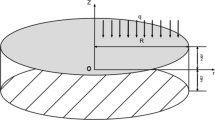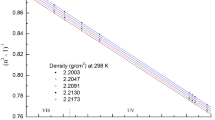Abstract
An electron paramagnetic resonance (EPR) probe consisting of two dielectric resonators (DRs) and a cavity (CV) is ideal for EPR experiments where both signal enhancement and tuning capabilities are required. The coupling of two DRs, resonating in their \({\text{TE}}_{01\delta }\) mode and a CV resonating in its \({\text{TE}}_{011}\) mode, is studied using energy-coupled mode theory (ECMT). The frequencies and eigenvectors of the three coupled modes are analytically derived. As predicted numerically, ECMT confirms that the \({\text{TE}}^{ + + - }\) and \({\text{TE}}^{ + - - }\) modes are indeed found to be degenerate at a specific distance between the two DRs \(d_{12}\). Additionally, the condition at which degeneracy occurs is specified. For a considerable range, the calculated frequency of the \({\text{TE}}^{ + + + }\) mode changes linearly with respect to \(d_{12}\). The \({\text{TE}}^{ + + + }\) mode showed a 500 MHz frequency change over a distance of 2 cm, when the resonance frequency is around 9.7 GHz. This enables the experimentalist to linearly tune the probe over this large frequency range. Finally the asymmetric configuration, where one of the resonators (DR2) is kept at the cavity center and the other one is allowed to move along the cavity axis, is studied. It is estimated that the frequency changes by 600 MHz over a distance of 1.5 cm. A formula for the magnitude of the magnetic field along the cavity axis, where the EPR samples are usually placed, is developed. This is crucial in determining the magnetic field in the vicinity of the sample and the probe’s filling factor.







Similar content being viewed by others
References
J.S. Hyde, W. Froncisz, T. Oles, J. Magn. Reson. 82(1989), 223–230 (1969)
Y.E. Nesmelov, J.T. Surek, D.D. Thomas, J. Magn. Reson. 153, 7–14 (2001)
A. Blank, E. Stavitski, H. Levanon, F. Gubaydullin, Rev. Sci. Instrum. 74, 2853–2859 (2003)
I. Golovina, I. Geifman, A. Belous, J. Magn. Reson. 195, 52–59 (2008)
R.R. Mett, J.W. Sidabras, I.S. Golovina, J.S. Hyde, Rev. Sci. Instrum. 79, 94702 (2008)
S.Y. Elnaggar, R. Tervo, S.M. Mattar, IEEE Trans. Microw. Theory Tech. 63, 2115–2123 (2015)
S.Y. Elnaggar, R. Tervo, S.M. Mattar, IEEE Trans. Microw. Theory Tech. 63, 2124 (2015)
S.Y. Elnaggar, R. Tervo, S.M. Mattar, J. Magn. Reson. 238, 1–7 (2014)
S.Y. Elnaggar, R. Tervo, S.M. Mattar, J. Magn. Reson. 242, 57–66 (2014)
S.Y. Elnaggar, R. Tervo, S.M. Mattar, J. Magn. Reson. 245, 50–57 (2014)
J.S. Colton, L.R. Wienkes, Rev. Sci. Instrum. 80, 035106 (2009)
S.M. Mattar, S.Y. Elnaggar, J. Magn. Reson. (San Diego Calif.: 1997) 209(2011), 174–182 (2011)
S.M. Mattar, A.H. Emwas, Chem. Phys. Lett. 368, 724–731 (2003)
A. Sienkiewicz, M. Jaworski, B.G. Smith, P.G. Fajer, C.P. Scholes, J. Magn. Reson. 143, 144–152 (2000)
A. Sienkiewicz, K. Qu, Rev. Sci. Instrum. 65, 68–74 (1994)
A. Sienkiewicz, B. Vileno, S. Garaj, M. Jaworski, L. Forró, J. Magn. Reson. 177, 261–273 (2005)
S.B. Cohn, Microw. Theory Tech. 16, 218–227 (1968)
M. Jaworski, A. Sienkiewicz, C.P. Scholes, J. Magn. Reson. (1969–1992) 124, 87–96 (1997)
A.J.S. Fiedziuszko, IEEE Trans. Microw. Theory Tech. 19, 779–781 (1971)
S.Y. Elnaggar, R.J. Tervo, S.M. Mattar, J. Appl. Phys. 118, 194901 (2015)
R.E. Hamam, A. Karalis, J.D. Joannopoulos, M. Soljačić, Ann. Phys. 324, 1783–1795 (2009)
S.Y. Elnaggar, J. Appl. Phys. 121, 064903 (2017)
I. Awai, IECIE Trans. Electron E88-C, 2295–2301 (2005)
Acknowledgements
SMM acknowledges the Natural Sciences and Engineering Research Council of Canada for financial support in the form of a discovery (operating) Grant. SMM also thanks the University of New Brunswick for the awards of Professor Emeritus and Honorary Research Professor. We would also like to acknowledge CMC Microsystems for providing the HFSS suite of programs that facilitated this research.
Author information
Authors and Affiliations
Corresponding author
Rights and permissions
About this article
Cite this article
Mattar, S.M., Elnaggar, S.Y. Modes and Fields of Two Stacked Dielectric Resonators in a Cavity of an Electron Paramagnetic Resonance Probe. Appl Magn Reson 48, 1205–1217 (2017). https://doi.org/10.1007/s00723-017-0931-8
Received:
Revised:
Published:
Issue Date:
DOI: https://doi.org/10.1007/s00723-017-0931-8




